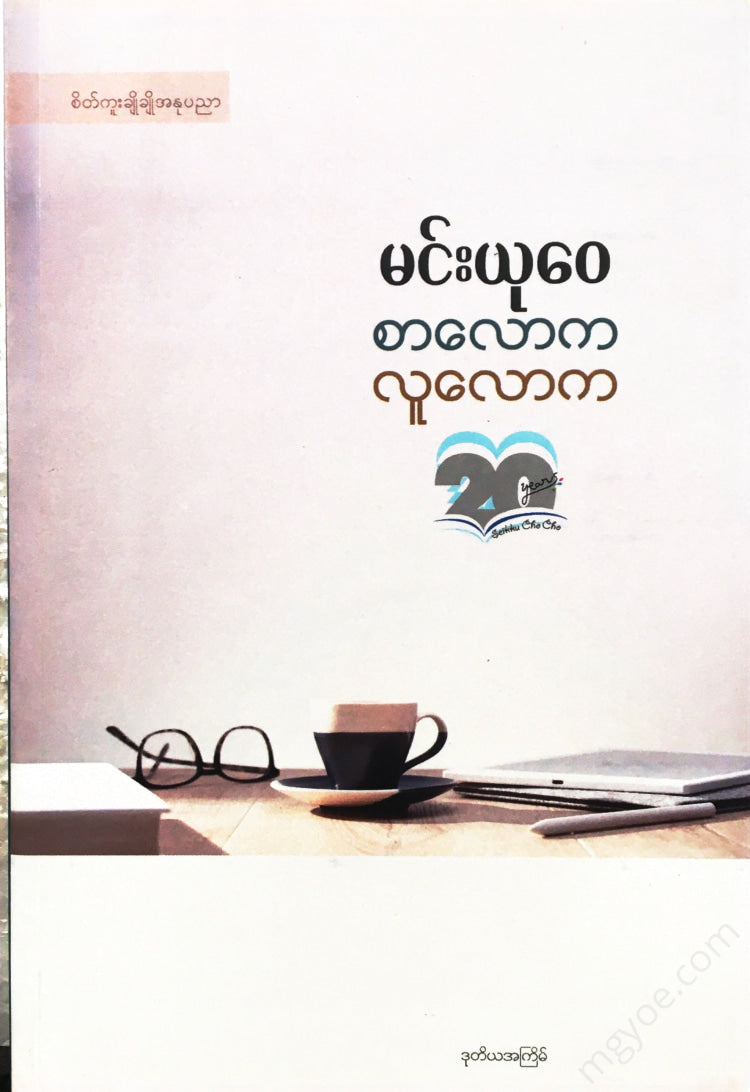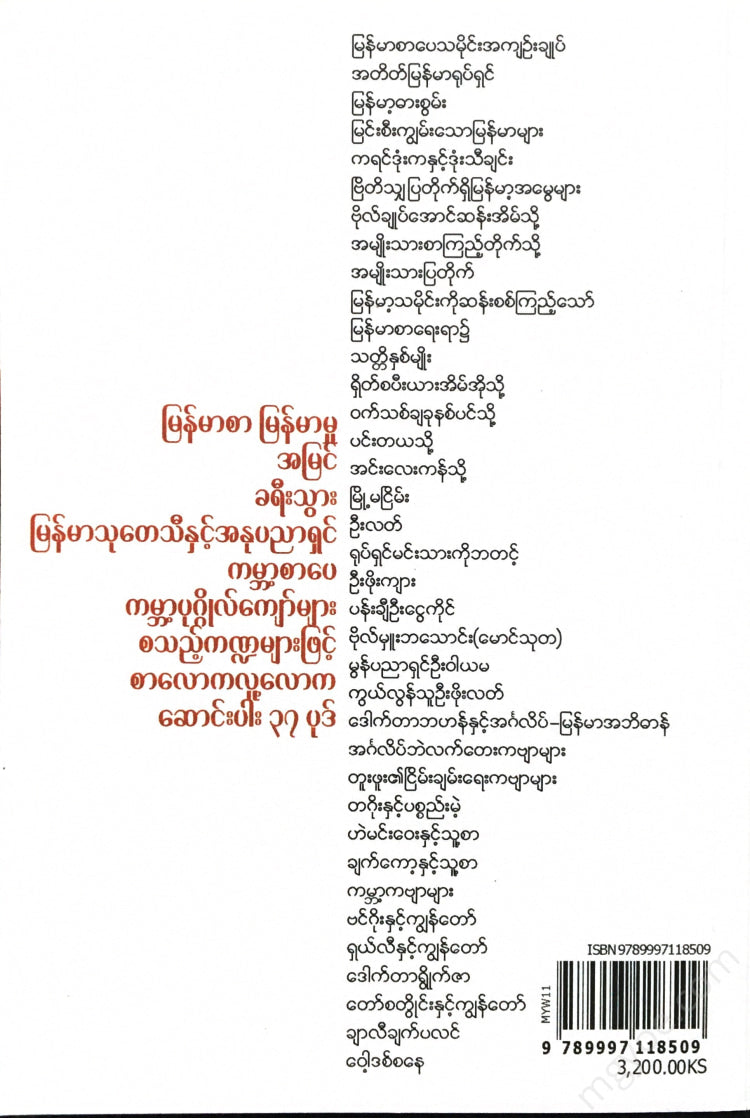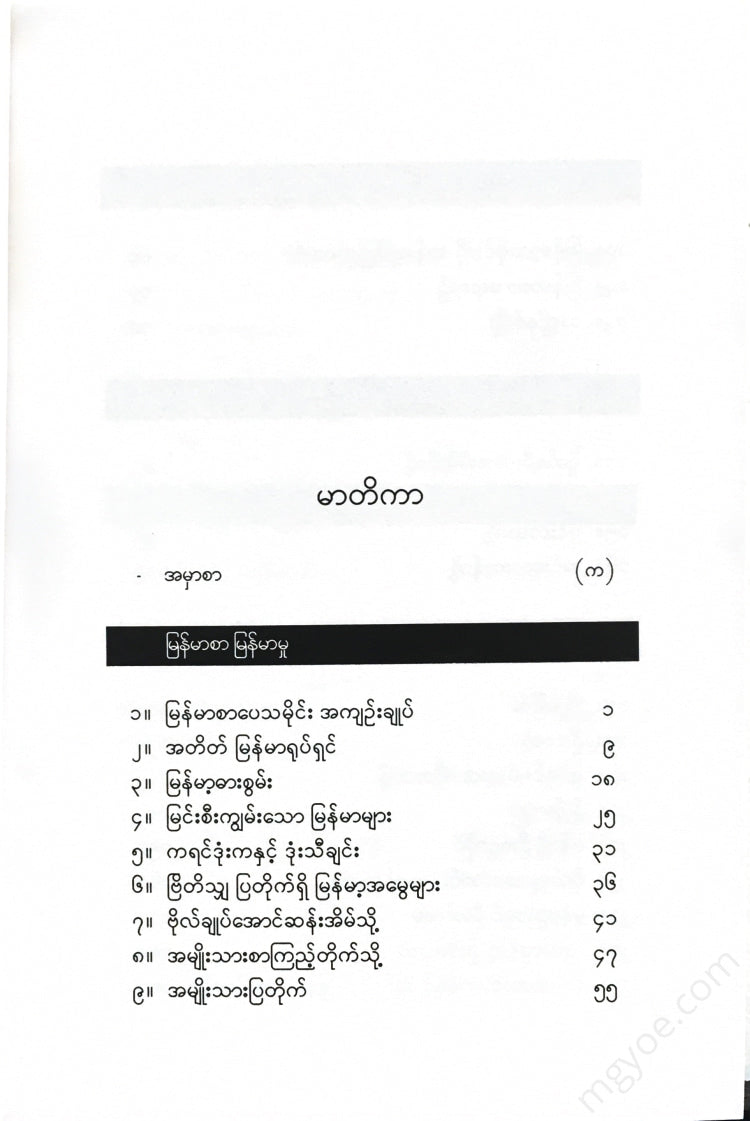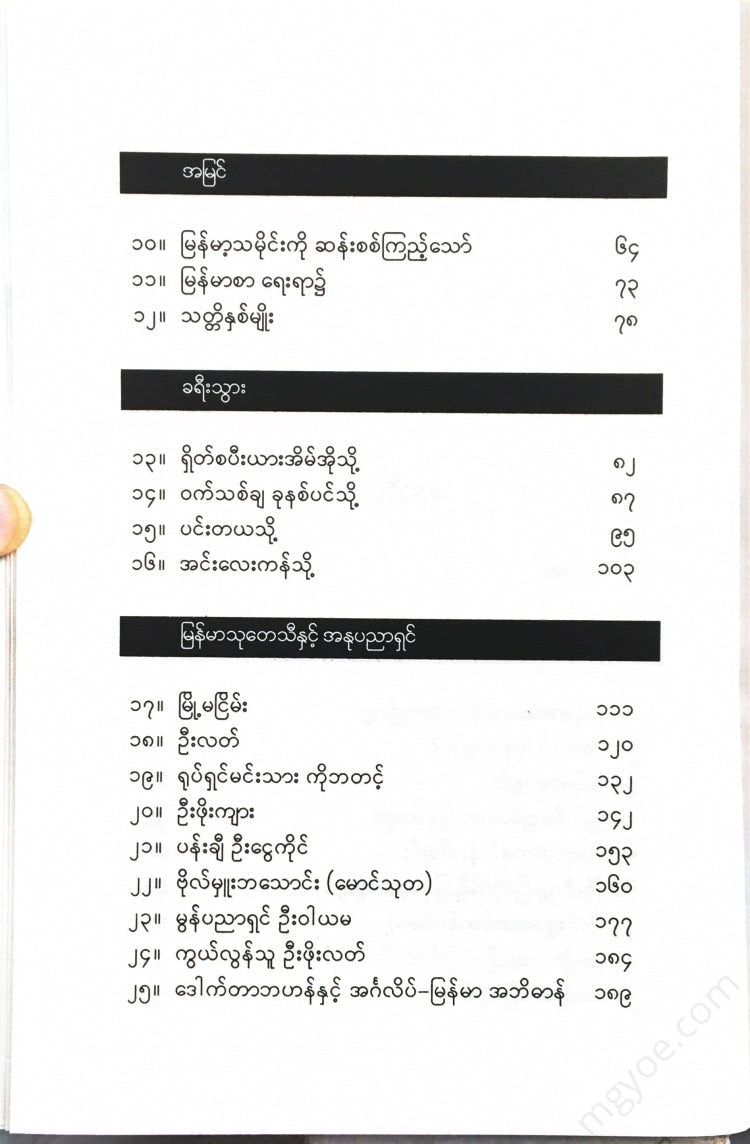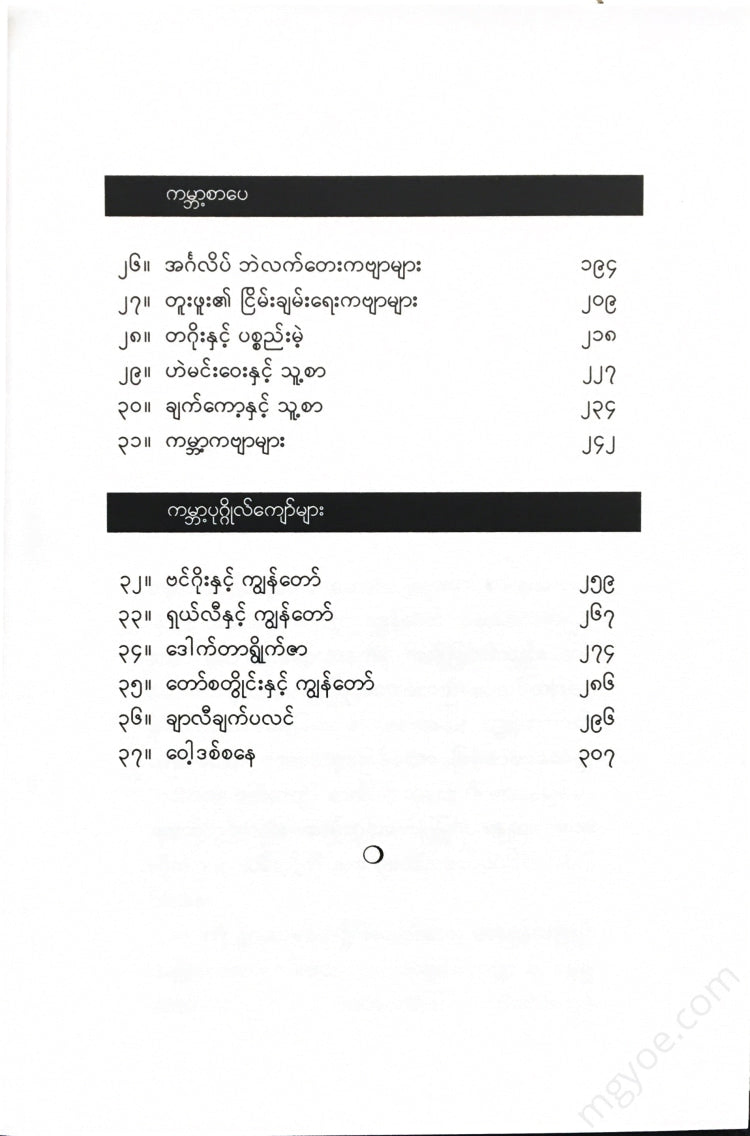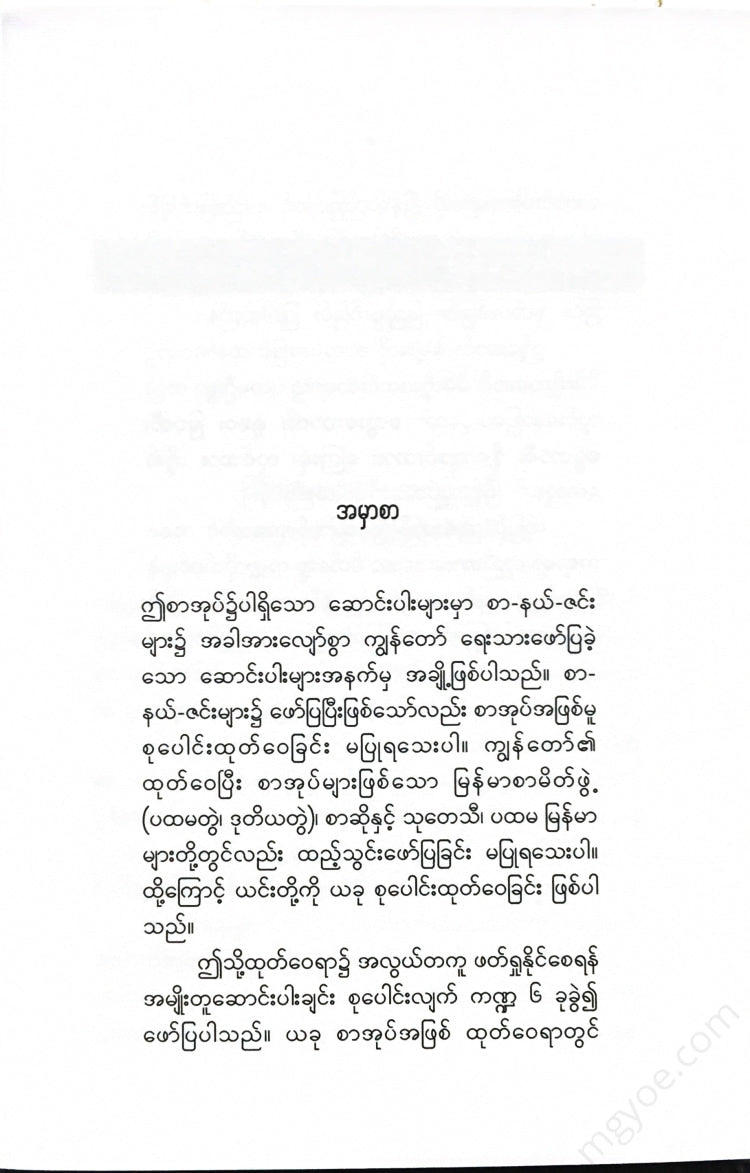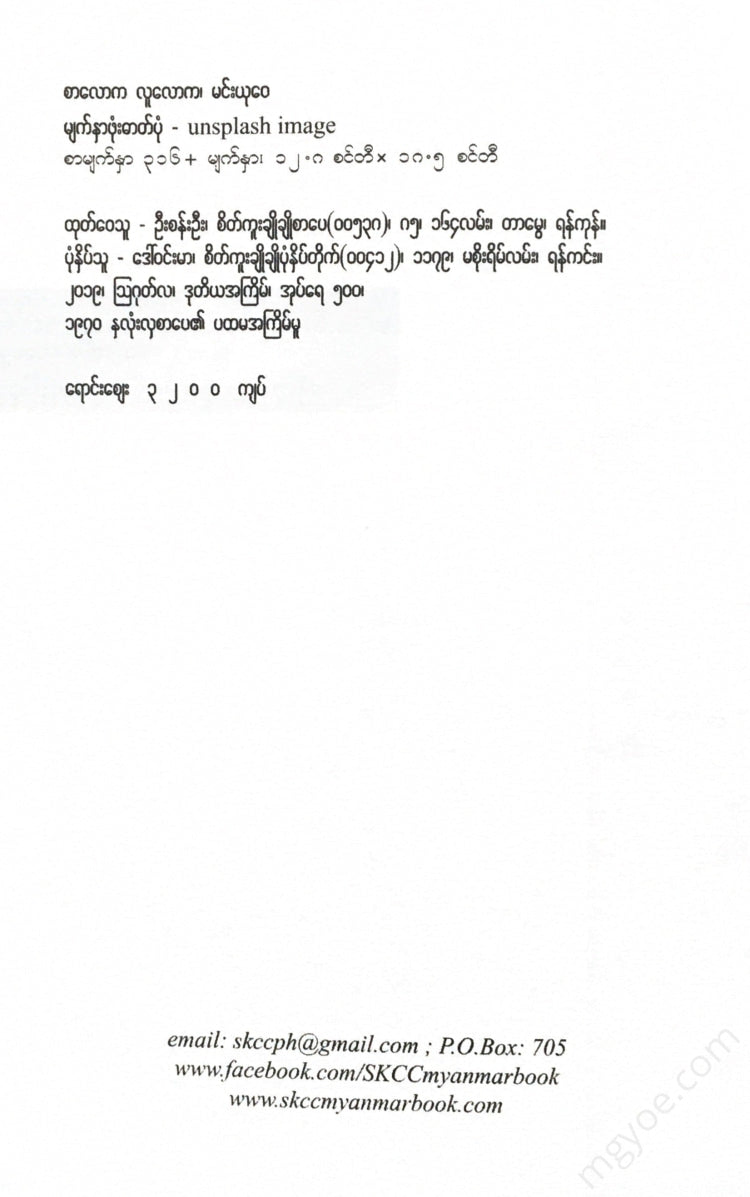စိတ်ကူးချိုချိုစာပေ
Min Yuwei - Literary World, People's World
Min Yuwei - Literary World, People's World
Couldn't load pickup availability
In world history, it is recorded that literature began to appear in Egypt and China about two thousand years before Christ. In Myanmar, it is said that Burmese literature began in the 11th century during the Bagan period.
If we look at Burmese literature in general, we can find three types: 1. Stone inscriptions 2. Pei and Purapaik inscriptions 3. Printed inscriptions. Among them, stone inscriptions were found in the Bagan period. Pei and Purapaik inscriptions were found from the Inwa period to the Konbaung period. Printed inscriptions were found from the British period after the British annexation of Lower Burma to the present day.
Among all the Burmese inscriptions found, the Mya Zed Stone Inscription, also known as the Gupyak Gyi Stone Inscription, is the earliest. It was inscribed in 1112 AD by Prince Rajakumara, the son of the Bagan King Kyansittha. It is not only in Burmese but also in Mon, Pyu, and Pali. Rajakumara inscribed the stone inscription so that future generations would remember his charitable deeds and know the boundaries of the land and property he donated. If you examine the stone inscription, you will see that it consists of four sections. These are 1. The year of donation 2. The reason for donation 3. List of donated items 4. Prayers and curses. These are written in prose. The writing is simple and elegant. Some of the sentence structure is Pali. Some of the vocabulary words are borrowed from Pali, Sanskrit, and Mon. The spelling is ancient. Generally, stone inscriptions from the Bagan period are found to have this style of writing. It is said that there are nearly a thousand stone inscriptions in Myanmar with this style of writing.
After the collapse of the Bagan period, the Inva period (1364-1555) emerged. In the Inva period, literature was written in the style of poetry and prose. Again, poetry was preferred over prose. The literary scholars of that period studied Buddhist literature and became interested in how humans should behave and plan for the present life, and based on the life cycle and the Buddhist scriptures, they composed poetry. The nine-chapter Satudhamsara by Maharatthasara, the Paramitaw Khan by Mahasilavansa, and the Naimybom Khan by Aggasamadhi are particularly notable. The Tollaratu by Uttama Kyaw, which focuses on the Buddha and describes the beauty of water, land, forest, and mountain, is also particularly notable. The study of Burmese literature during that period was strong. The Burmese use of four-syllable rhymes has reached a level of poetic and delightful sophistication.
Then came the Taungoo period and the Nyaungyan period (1515-1752). During that period, poems that emphasized the sorrow of going to war, the joy of winning the war, praising the king's glory, and the love and longing of men and women were popular. The poems of Nawaday and Natshinnaung on the Battle of the Bulge, the Battle of the Bulge, the Battle of the Bulge, the Battle of the Bulge, the Battle of the Bulge, the Battle of the Bulge, the Battle of the Bulge, the Battle of the Bulge, the Battle of the Bulge, the Battle of the Bulge, the Battle of the Bulge, the Battle of the Bulge, the Battle of the Bulge, the Battle of the Bulge, and the Battle of the Bulge, the Battle of the Bulge, and the Battle of the Bulge, were prominent poems of that period. What was unique about that period was the emergence of the poems of the minister Padeya Raja, which depicted the lives of workers and farmers. In addition, poems that depicted the feelings and lives of the villagers also appeared. In addition, the "Book of the Royal Revolution" by Mon minister Banyadala and the "Maha Rajawin Kyin" by U Kala also appeared. These are concise, clear, and concise prose texts that are worthy of being set as standards in the world of Burmese prose.
Then we come to the Konbaung period (1752-1885). The study of Pali scriptures that began in the Bagan period and the study of Burmese literature that began in the Inva period settled down in this period. The essence began to accumulate. The scholars of that period studied and compiled the scriptures that their ancestors had studied and compiled over the generations. They patched up the damaged ones. They uncovered the obscure ones. The scholars led by the missionary Sayadaw edited the Pitaka and engraved them in stone. They also edited and refined the Dhammasatya, the medical books, the Vedic books, the historical books, etc. They collected and recorded the Pitaka, the secular books, the Poo Lanka, the history, etc. In this way, while preserving the old books and scriptures that were the heritage of their ancestors, they also compiled new books. The Linatha Dipani, They compiled valuable literary works such as the Book of Words, the Commentary on the Pooranakatha, and the Book of Punctuation and the Book of Punctuation. A group of modern scholars led by King U Bo Hlaing also attempted to translate Western science and technology books into Burmese. Although the poets of the Poo Lingkas could not compose new poems, they continued to compose traditional poems without breaking the tradition. The most notable of these were short poems such as Laycho, Tey Dat, Baw Le, Than Cho, and Lum Chin. In addition, many poems, plays, and love letters also appeared. U Punya's novels, love letters, and U Kyen U's plays are unique. Among the literary leaders of that period were Mongyul Sayadaw, Shin Okkan Thamala, Second Kyaw Aung San Thar/Sayadaw, Seinta Kyaw Thu U Thu, Dwin Thin Mingy, Myawaddy Mingy, U Bo Hlaing, U Kyen U, Hlaing Theik Khaung Tin, U Punya, King Kin Wan Mingyi, etc. were among the top leaders.
During that time, in 1869, King Mindon established a printing press in the North Garden of the Golden Palace in Nay Pyi Taw. He began his efforts to publish the Burmese literary texts that existed only in the past, present, and future. In 1874, the newspaper Yadanarbon was published.
Just as the foundation of Burmese literature was being laid, Burma fell under British colonial rule. Burmese culture and Burmese sciences, along with Burmese literature, also faded away.
During this period, printing houses became popular in Lower Burma. Printing houses were established in Upper Burma in 1869, but in Lower Burma in 1816. These printing houses printed and published plays with lyrics and songs for performances. In order to print them, both upper and lower caste playwrights gathered in Yangon and wrote plays. It is said that there were more than one hundred or two hundred plays published in this way. In addition to these plays, some old books and manuscripts were also printed by printing houses. Here, Burmese literature, which had been weakened by the colonial era, was struggling to regain its strength. The literature of the Buddhist scriptures (Wa), which had previously been confined to monasteries and royal palaces, spread to the villages of the common people thanks to the printing industry. It changed from a minority literature to a majority literature.
Then, when plays became popular and popular, period novels appeared. The first period novel was “Maung Yin Maung Ma Mae Ma” by Jane Hla Kyaw. The novel was a Burmese translation of a part of the novel The Count of Monte Cristo by the French writer Dumas. After this novel, U Gyi’s Sour Paung Yaew appeared, Maung Mhoing’s novel, U Ba Tin’s Maung Tanaw’s novel, U Lat’s Shwe Pyi Soe’s novel, Sapae Pin’s novel, Mr. Maung Mhoing’s (Thakhin Heng Taw Mhoing’s) novel, etc. These novels began to include human nature groups that combined and summarized the events of the world around them, human affairs, and human behavior.
When the first student strike of 1920 broke out, Burmese literature advanced a step further. The pursuit of poetry expanded. Many poems appeared in newspapers such as Vyin Alin, Thuriya, and Myanma Alin, and in magazines and journals such as Dagon Magazine. However, the content was dominated by Mae Bwe, Maung Bwe, Alum Bwe, Alah Bwe, and Than Waiga Bwe, so it was not very encouraging. In other words, it could be said that it was still the poetry of the Mandalay era. However, Mr. Maung Mhoing composed unique poems. These poems were not Mae Bwe, Maung Bwe, Alum Bwe, Alah Bwe, and Than Waiga Bwe, but poems that aroused the blood and spirit of the people.
Then, the Burmese struggle for independence and the study of foreign literature expanded, and writers such as Shwe U Daung, Pi Moe Ning, Letti Pandita U Maung Gyi, Zeya, Maha Swe, Dagon Khin Khin Lay, U Phoe Kyar, Nyarna, and Thakin Ba Thaung emerged. Writers such as Saung Maung Wa, Zaw Gyi, Min Thu Wan, Maung Htin, Tat Pho Gyi Thein Pe (Thein Pe Myint), Tat Toe, and Dagon Thara emerged from the university. These writers wrote long and short stories, plays, articles, papers, and poems with great energy. Prose stories, short stories, plays, articles, papers, etc. were more powerful than poetry. In terms of the content of the writing, priority was given to the human nature that combines the events of the world around us, human affairs, and human behavior. The spirit of independence and patriotism, Priority is given to topics that inspire patriotism. Looking at the style of prose writing, the style of writing that was popular during and after the Mandalay period, which was a mixture of prose and prose, and rhymed writing, began to be written in a style that was simple, easy to understand, and easy for the public to understand.
In terms of poetry, Zawgyi and Min Thuwan began to compose contemporary poetry. Contemporary poetry is a new form of poetry that has broken away from the old traditional Burmese poetry in terms of content and form. In other words, it is a type of poetry that expresses the knowledge gained from the experience of experiencing the world around us, human affairs, and human behavior in a clear, simple, and concise manner.
This is a brief history of the gradual changes in Burmese literature, from the Bagan period to the period before World War II in 1940.
Our student, 1969.
Books: History of Burmese Literature (U Pe Maung Tin), World of Literature (Zaw Gyi, Min Thu Wan), Selected Works of Bagan Stone Carvings (Professor U Aye Maung), Burmese Literature and the West, Part 1, 2, 3, 4, 5, 6, (Dr. Hla Pe), Biography of Saya Lun (Thein Pe Myint), Myanmar Eyes (Zeyya), Introduction to Literature (Zaw Gyi), Introduction to Literature (Zaw Gyi), Commentary on the Author (Zaw Gyi), Flowers and Plants (Min Thu Wan), Burmese Literature (Min Thu Wan), Burmese Literature, Burmese Literature, and the Burmese Literature (Tai Soe, Min Yu Wai), Poets and Scholars (Tai Soe, Min Yu Wai).
